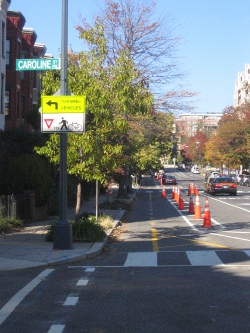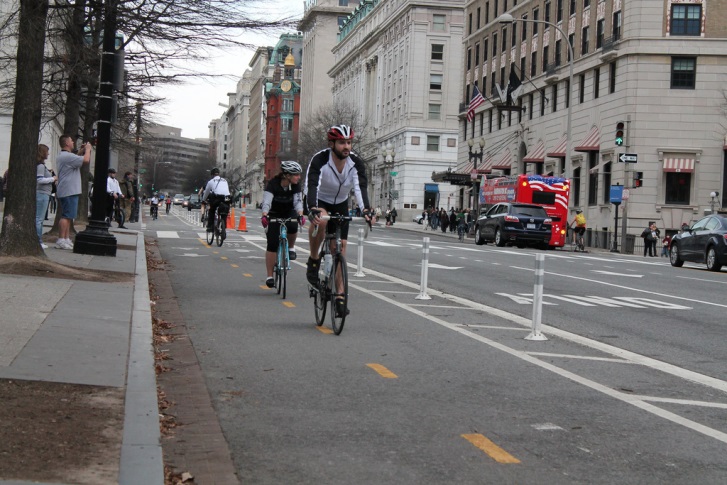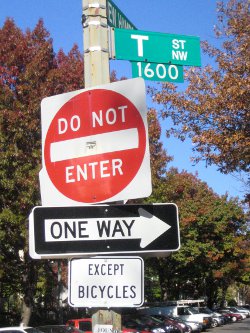15th Street Cycle Track Design and Implementation
Washington, District of Columbia
Problem
 The two-way cycle track on 15th Street in Washington, D.C.
The two-way cycle track on 15th Street in Washington, D.C.Photo by Graham Pitts.
Residents along 15th Street, a higher-speed one-way road which serves as an express route out of Washington D.C., sought alternatives to calm traffic along the corridor. The District of Columbia designed a two-way bicycle facility to create separated space for bicyclists on a high-speed, one-way corridor.
Background
Many of the residents living on and around 15th Street were unhappy with the high speeds on the road with a posted speed limit of 30 mi/h and, along with neighborhood associations, advocated for a solution. In response to the interest in this corridor, transportation planners at the District Department of Transportation (DDOT) revisited a previous analysis that had been conducted on 15th Street and ultimately proposed four alternatives for the redesign of the street. Based on modeling software, which evaluates the level of traffic and amount of delay on the roadway, the planners determined that traffic would not be unduly affected by a one-lane reduction. As a result, two of the four alternatives involved reducing the road by one motor vehicle travel lane and adding bike lanes or cycle tracks, while the other two would have opened the street back up to two-way traffic. Many people were in favor of altering the traffic configuration back to two-way traffic, but the two million dollar price tag associated with re-striping the road and installing new signals proved to be a major stumbling block.
 Bicyclists using the 15th Street cycle track, between E Street and Pennsylvania Ave.
Bicyclists using the 15th Street cycle track, between E Street and Pennsylvania Ave.Flikr user Elvert Barnes.
Countermeasure
Following an intensive public process—which involved holding a public meeting, providing flyers to nearby residences, facilitating discussions with Advisory Neighborhood Commissions, creating blog and listserv posts, conducting surveys, and coordinating with the Washington Area Bicycle Association—DDOT planners found a compromise. By maintaining one-way traffic flow, planners preserved an easy and convenient route out of Washington, D.C., while implementing a road diet to reduce automobile speeds, provide space for a cycle track adjacent to the roadway, and meet the needs of neighborhood residents.
Cycle tracks are facilities that are for use primarily and sometimes exclusively by bicycles. They are separated from other street facilities (sidewalks, vehicle travel lanes, parking lanes) by bollards, markings, or a combination of the two. In this case, the cycle track, which allowed for contraflow bicycle traffic, was located between the sidewalk and the on-street parking, and used flexible channelizing posts to differentiate between vehicle parking and the cycle track. To avoid confusion at intersections, striping and signage were used to make drivers aware of bicycles and vice versa. In particular, "Watch for Turning Traffic," "Bikes Use Ped Signal," and "Turning Vehicles Yield to Pedestrians and Bicyclists" signs were used.
 Signs for motorists and bicyclists on 15th Street.
Signs for motorists and bicyclists on 15th Street.Photo by Graham Pitts.
While the public process for the cycle track on 15th Street took over six months and the entire 15th Street corridor analysis has been ongoing since 2005, the construction of the facility was completed in a matter of weeks. As the first application of a cycle track in Washington D.C., the 15th Street installation served as a pilot for other cycle track installations across the city. In November 2010, the facility was expanded to a two-way cycle track between E Street/Pennsylvania Avenue and V Street.
Evaluation and Results
The opening of the cycle track generated significant media coverage in Washington D.C. and has been successful in boosting bicycle ridership and reducing vehicle speeds along the corridor.
DDOT conducted a number of before and after studies, bike counts, traffic volume analysis, speed analyses, intercept surveys, and an online neighbor survey to evaluate the changes caused by the project. Their analysis indicates that cyclists are pleased with the facility, more cyclists are using the facility than before, and that some traffic calming has occurred as a result of the cycle track. Several features of this project are still experimental, and the design for this type of facility in the U.S. is still evolving as cities and transportation agencies work together to determine best practices.
Crash data were obtained from before the installation of the bicycle facilities (2005-2009), after the installation of the one-way cycle track (2009-2010), and after the installation of the two-way cycle track (2010-2011). Overall, the bicycle facilities did not appear to have caused significant changes in crash patterns, although frequency increased in two of the three segments on the 15th Street corridor.
Conclusions and Recommendations
Having only two years of data after the facilities were constructed does not provide a comprehensive view of conditions after installation of the facilities, and crashes should continue to be monitored at these locations to compare longer-term crash patterns. As more crash data are collected, they should also be adjusted for exposure since initial counts during the p.m. peak hour found that bicyclist volumes on some segments have increased by over 200 percent.
Cost
The cost of this project was $5.6 million.
Contact
William P. Carr
Director of Research, Transportation Planning and Policy Administration
(202) 671-1371
Resource
District Department of Transportation. DDOT Bicycle Facility Evaluation Final Report. 2012. Available at: http://ddot.dc.gov/publication/ddot-bicycle-facility-evaluation-final-report-summary-evaluation-and-recommendations

